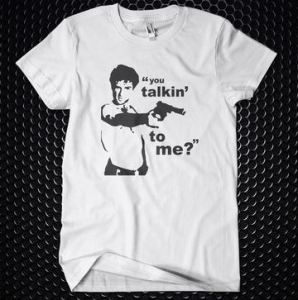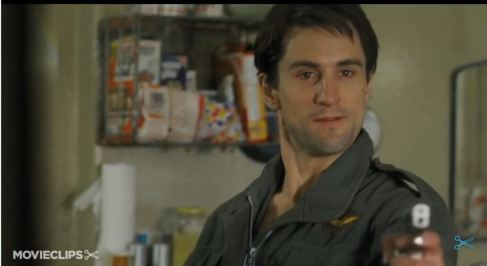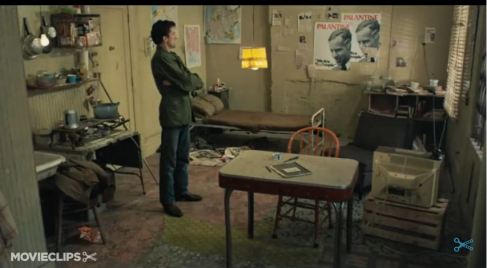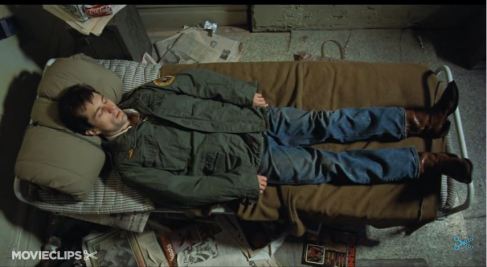If you had asked me what my favourite film was at any point since I was around 18 I would have instantly answered Taxi Driver (I may have cost myself a temp job at Odeon by putting it down as the film to have on my name badge). I had dropped out of college and was working for minimum wage and it was during this time that my love of film flourished and became one of the most important things in my life. I remember well the beginning of this voyage of discovery with so many great and revered films that I was yet to see, a feeling of excitement and possibility that is inevitably unsustainable, waning under the weight of years of ferociously devouring the canon.
It was near the beginning of this newfound passion, curiosity and desire to see the established greats that I picked out the Taxi Driver DVD that my Dad had recently bought (his collection was relatively small but almost exclusively classics.) I was blown away. It was my identification with the main character Travis Bickle that hit home in a transformative way, the way the film articulated his loneliness, disillusionment, alienation, and disgust with the outside world was so powerful to me. I felt all these things. Not only did I come to appreciate its mastery as a piece of film making on every level and a performance that was note perfect from Robert De-Niro, to me the film was very personal – an evocation of my deep sense of not belonging, of living a life without meaning, of not being like others, of being broken and alone. I bought this poster and read the tagline every morning waking up:
“On every street there’s a nobody who dreams of being somebody. He’s a lonely forgotten man desperate to prove that he’s alive.”
A rare tagline that is actually representative of the film’s core – I felt these words and although I would distance myself from the racism and murderousness, in many ways I felt I was Travis Bickle.
I have always found it strange how the image of Travis Bickle has been appropriated as a symbolic macho icon in a similar way to say Tony Montana from Scarface where their image appears on t-shirts and other such paraphernalia as seemingly a masculine ideal albeit a criminally subversive one. To me that is not Travis Bickle and to see the character in this way is to miss the point. Travis is not to be admired, he is to be pitied, he is in many ways a pathetic character and his attempt to give his life meaning is a desperate, impotent and useless foray into suicidal violence.
Happily I can say that I feel much less like Travis Bickle now, the terrible loneliness portrayed in the film is no longer what defines my internal life, but it did for many years. With the deep feeling of resonance that I had now in the past can I still say Taxi Driver is my favourite film? Well I still believe it to be a masterpiece and I don’t believe it would ever leave my top 3 but I have come to believe that to choose just one film as an all time favourite would be impossible and perhaps reductive. It shows to go ya how our relationship with certain films can change over time. For its time and place in my life there was no film more achingly, beautifully, horribly relevant and resonant to me.
When looking up the ‘You Talkin’ to Me’ scene to post I saw a comment that proved I was certainly not alone in feeling they way I did towards the film:
I look forward to revisiting it and seeing it on the big screen for the first time at Cinema City Norwich on June 14th with an introduction as part of their ongoing ‘Philosopher’s at the cinema’ season.
Tickets are available here:
https://www.picturehouses.com/cinema/Cinema_City/film/taxi-driver-35th-anniversary-restoration
Here I present one of the first Film Studies essays I ever wrote a close analysis of the ‘You Talkin’ To me?’ scene from Taxi Driver.
How are editing, cinematography and sound used to create meaning, develop character and generate response in the “You talking to me?” scene from Taxi Driver (Martin Scorsese, 1976)
Taxi Driver revolves around Travis Bickle – a sociopathic Vietnam War veteran and his descent into isolation, insanity and eventually violence. The scene I am scrutinising is seminal to the character development of Travis. It shows him rehearsing violent acts with an imaginary adversary, becoming further engrossed into a fantastical identity and reality. In the scene, Scorsese is able to communicate the state of Travis’s character and most importantly its progression through jittery editing, placement of camera and use of sound.
The scene opens with a close-up on Travis’s hand spinning a gun around his finger. He is looking in the mirror. The gun spinning is reminiscent of a protagonist from a western, it displays a fantasy of identity for Travis – that of a gunslinger hero vigilante. There is only diegetic sound at this point, giving us a sense of gritty realism and intensity.
The scene cuts to a full body shot of Travis putting on his army jacket. There is an arsenal of guns and holsters on display, showing us that Travis is preparing himself for war. The camera is on the mirror and we are seeing Travis in reflection. The mirror is important because Travis uses it to create an opponent, further mystifying his idea of self. A 180-degree whip pan from the mirror image back to a medium close up of Travis is used; this disorientating effect makes it difficult to differentiate between Travis and the mirror image of himself. This technique effectively implies that the violent action that Travis is preparing to take is as much against himself as against the victim – as much an act of suicide as an act of murder.
Travis begins to interact with his mirror image and mutters incoherently, repeating the grunt “Huh!” This will become his cue to pull the gun, thereby making the audience feel ill at ease every time he says it. The scene cuts to a medium close up of Travis’s midsection. At the same time as “Huh!” he pulls a gun from his sleeve almost directly at camera. This technique implicates and involves the audience in his actions. He says “Huh!” and the scene cuts to a medium close up of him pointing the gun. Again the cut is synchronised with the sound.
The camera stays on this shot as Travis taunts his imaginary adversary and pulls the gun again. Keeping the camera on him rather than cutting back between him and the mirror intensifies the mock violence and gives us a sense of subjectivity. Travis addresses his mirror image but also addresses the audience. “You make the move, it’s your move.” In this realistic recreation of a typical altercation we get the sense that Scorsese is implying that Travis is not so much removed from the real world as he is completely absorbed in an imaginary world of his own creation.
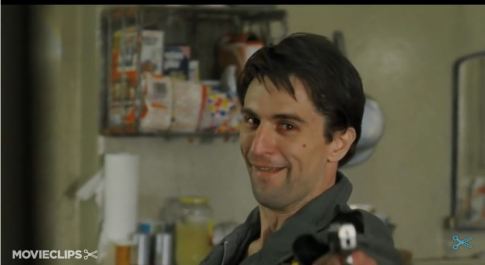
The scene cuts to a medium close up of Travis’s midsection as he puts the gun away. A quick cut back to a medium close up of Travis’s face is synchronised with the first utterance of “You talkin’ to me?” Travis is on the far right edge of the screen, to show the off-centered nature of his character. Travis repeats the line, surveys the room and pulls the gun again, with no cuts – again to intensify Travis’s action by not allowing us to look away. He pulls the gun and again repeats the grunt “Huh!”
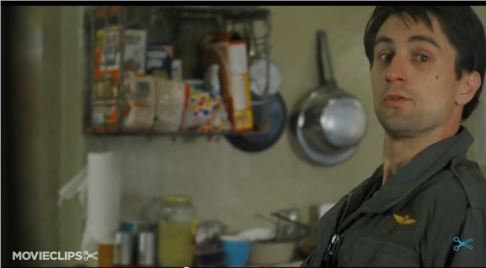
The scene cuts to a medium long shot of Travis still looking in the mirror. This choice of shot shows Travis’s surroundings in more detail. He is no longer looking into the camera, so removing the audience from implication and back into objective consideration of Travis’s mental state. There is a quick dissolve into a medium close up of Travis in the same position.The first non-diegetic sounds occur.
First we hear a ticking clock, representing the building insanity in Travis and implying that he is a “Time-bomb” ready to explode with violence. The sinister Bernard Herrmann score begins with long notes from organs and synthesisers, lingering with the presence of a Hitchcockian thriller. The score is used to immediately disturb, unsettle and further our perception of Travis as an increasingly dangerous force. As Travis’s voice over begins there is another dissolve to him in the same position but on the other side of the screen. These quick dissolves have the same disorientating effect as the whip pan earlier.
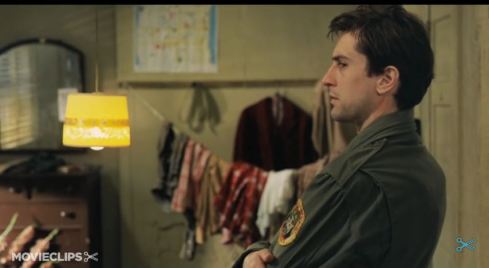
Travis begins to swivel round and the threatening voice over begins. It stutters and stops and the scene cuts back to Travis standing in the same position –the voice over starts again. This technique of starting and stopping is used to remind the audience that Travis is rehearsing and that the violent character who has been threatening and chastising a fictitious adversary and us in the scene is in fact totally a work of Travis’s imagination. Through this imperfect rehearsal we are once again shown the fallibility of Travis. The pure fantastical creation of this gunslinger “Bad ass” of which we were but moments ago convinced and frightened of, we see in a different light.
The scene cuts to a high angle shot of Travis lying down on his bed, juxtaposed with the ominous threatening voice over, giving us not a sense of Travis at rest (we already know he can’t sleep) but of a dormant insanity and desire for violence which is increasingly near to the surface.
The scene cuts to an extreme close up of a pencil and notepad. The camera pans across the page and stops dead revealing the words “Here is” at the same time the voice over says them, letting us know the voice over is his diary. Stopping on those words is a device to make the audience reflect on just what there is, what we now have in Travis, a man becoming more and more involved in an imagined reality and a fantastical identity. It serves as a tool to make the audience sum up what they have just seen and re-evaluate the character of Travis. Provoking this reaction is an integral function of character development in film.
The scene quickly cuts to the same medium close up of Travis’s face pointing a gun from earlier. But this time the shot lingers on for much longer, until Travis finally says “You’re dead!” A long menacing organ note builds tension and acts a reverb for the imaginary gunshot Travis has just fired. As Travis says this the non-diegetic sound of a woman’s scream is heard, inciting the response that Travis has become something dangerous, something to fear. The woman who screams is not shown and the anonymity implies universality to Travis’s potential victims.
The editing style of the sequence is very fast paced. Jump cuts and quick dissolves make the scene look fragmented, a representation of Travis’s deluded, paranoid and confused mind state. The quick edits between mirror image and Travis himself are a tool of misidentification for both the audience and character. It demonstrates both projection as Travis lets his frustrations manifest themselves into mock violence and reflection as Travis studies himself in the mirror we as the audience are considering the implications of Travis’s continuingly obscured perceptions of reality and identity.
Within the scene Scorsese uses a contrast of styles, realism and expressionism. We can see this in the use of sound. The first half of the scene contains only diegetic sound. Taxi Driver is an extremely subjective film and this is an effective technique of placing the viewer in the characters shoes by letting them experience nothing that Travis doesn’t. It also accentuates the sound effects of Travis’s gun play, making them all the more disturbing. In the second half, an effective use of non-diegetic sound is employed with the harrowing voice over mixed with Bernard Herrmann’s score. This gives a sense of great unease and makes the words that Travis is saying all the more powerful and haunting.
For most of the scene, Scorsese uses medium close ups on Travis as he practices with his various guns. Medium close ups are often used for conversations in film, which is why it is used here: Travis is talking to himself. The cinematography of the sequence works in much the same way as the editing in the representation of Travis’s mind state and development of character. The camera is positioned in a way that often has Travis off-centre and successfully mixes the subjective and the objective with close ups contrasted with a medium long shot and the high angle shot of Travis lying on his bed.
Through all these techniques Scorsese successfully manages to let the audience experience what Travis is experiencing and almost empathise with him. At the same time he lets us look at the character from an outside perspective, developing our emotional bond to Travis and our perception of him. So succinct, successful and powerful is this scene in progressing/developing this iconic character that it is not only the most famous scene in the film but one of the most well known scenes in film history.


